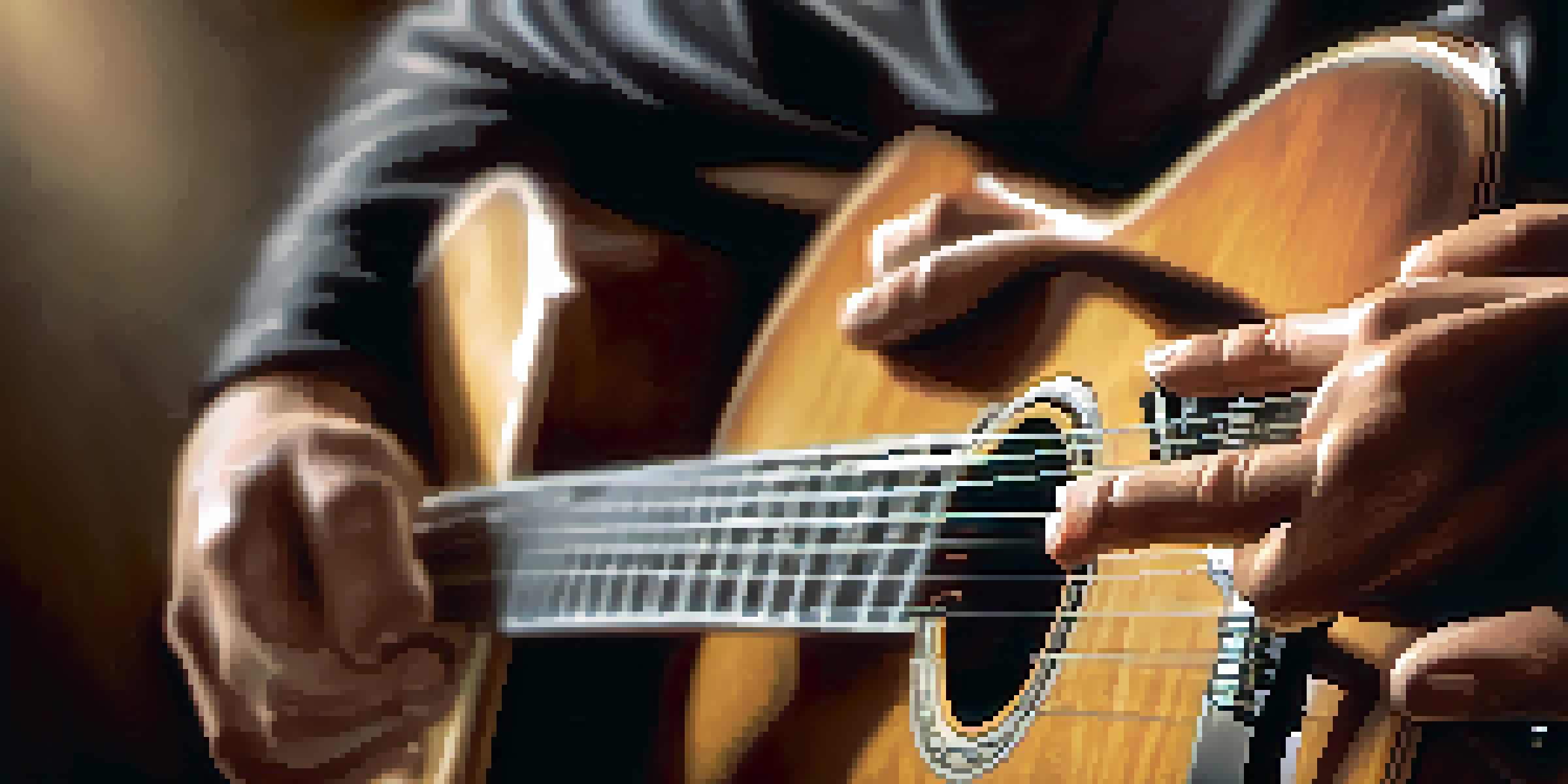Exploring Different Rhythmic Patterns for Guitar Playing

Understanding the Importance of Rhythm in Guitar Playing
Rhythm is the heartbeat of music, and for guitarists, it shapes how melodies and chords resonate with listeners. Without a solid grasp of rhythm, even the most skilled players can sound disconnected. Think of rhythm as the foundation of a house; without it, everything else can crumble.
Rhythm is the soul of music, and without it, melody is just a ghost.
Mastering rhythmic patterns allows guitarists to explore different genres, from rock to jazz and beyond. Each style has its unique feel, and rhythm helps define that character. For example, a bouncy swing in jazz differs significantly from the driving beat in rock music.
Incorporating varied rhythms not only enriches your playing but also engages your audience. A familiar song can take on new life with a simple change in rhythm, showcasing your creativity and skill. So, let’s dive into different rhythmic patterns that can elevate your guitar game!
Exploring Basic Rhythmic Patterns for Beginners
If you're new to guitar, starting with basic rhythmic patterns is crucial for building your skills. Patterns like quarter notes and eighth notes provide a solid foundation. Think of them as the simple building blocks of rhythm that, when combined, create a beautiful structure.

For instance, strumming a simple down-up pattern can help you feel the groove of a song while allowing you to focus on chord changes. This basic technique is the first step towards more complex rhythms. As you grow more comfortable, you can start experimenting with different strumming speeds and accents.
Rhythm is Music's Backbone
Understanding and mastering rhythm is essential for guitarists as it shapes how melodies and chords resonate with listeners.
Practicing these patterns regularly will help you develop muscle memory and a better sense of timing. It’s like learning to walk before you run; mastering the basics sets you up for more intricate rhythmic explorations down the line.
Incorporating Syncopation into Your Guitar Playing
Syncopation adds an exciting twist to your rhythm by emphasizing off-beats, creating a sense of surprise and groove. It's like dancing to a beat that keeps you on your toes, making your music more dynamic and engaging. Many popular genres, including funk and jazz, rely heavily on syncopated rhythms.
Music is the shorthand of emotion, and rhythm is its heartbeat.
To practice syncopation, try playing a simple chord progression and accenting the off-beats with your strumming hand. This technique can transform a straightforward riff into something captivating. For example, adding a short pause or a muted strum on the off-beat can create a funky groove.
As you get comfortable with syncopation, challenge yourself with more complex patterns. Incorporating this rhythmic element into your playing will not only enhance your technique but also make your music more compelling to your listeners.
Experimenting with Polyrhythms for Advanced Players
Polyrhythms involve playing two contrasting rhythms simultaneously, creating a rich tapestry of sound. They can be tricky to master, but the payoff is immense—think of it as a musical conversation between different voices. Many advanced guitarists use polyrhythms to add depth and complexity to their compositions.
To get started, try playing a simple pattern, such as a steady eighth note, while adding a syncopated rhythm on top. This layering creates an intricate sound that captivates the ear. For example, while strumming a constant quarter note, incorporate a sixteenth note rhythm in your lead playing.
Syncopation Adds Excitement
Incorporating syncopation into your playing emphasizes off-beats, creating a dynamic and engaging musical experience.
As you practice, listen closely to how these rhythms interact. The more you experiment with polyrhythms, the more comfortable you’ll become with blending different styles, leading to truly unique musical expressions.
Using Rhythmic Variation to Enhance Songwriting
Rhythmic variation can breathe new life into your songwriting, keeping your music fresh and unpredictable. Just like a good story has twists and turns, varied rhythms can keep listeners engaged and eager for what comes next. Think of it as adding spices to a dish—you want to create a flavor explosion without overpowering the main ingredients.
For example, try alternating between a steady strumming pattern and a more intricate picking pattern throughout a song. This contrast not only highlights different sections but also showcases your versatility as a guitarist. You might find that switching up the rhythm at key moments elevates the emotional impact of your song.
By weaving rhythmic variations into your songwriting process, you’ll discover new melodies and ideas, transforming your music into a rich tapestry of sound that reflects your unique style.
The Role of Rhythm in Different Musical Genres
Every musical genre has its own signature rhythmic style that sets it apart from others. For instance, the steady beat of blues contrasts beautifully with the complex syncopations found in jazz. Understanding these rhythmic differences is essential for any guitarist looking to explore various styles.
Take rock music, where the backbeat is often emphasized, creating a driving energy that gets people moving. In contrast, classical guitar often features intricate fingerpicking patterns that require a different approach to rhythm. Recognizing these nuances can help you adapt your playing to fit any genre you wish to explore.
Rhythmic Variation Enhances Songwriting
Utilizing rhythmic variation in songwriting keeps music fresh and unpredictable, allowing for greater emotional impact.
By immersing yourself in the rhythms of different styles, you’ll not only enhance your versatility but also gain a deeper appreciation for the music you love. This awareness can inspire you to create songs that blend elements from various genres, resulting in a unique sound that’s all your own.
Tips for Practicing Rhythmic Patterns Effectively
To truly master rhythmic patterns, effective practice is key. Start by setting aside dedicated time each day to focus solely on rhythm exercises. Think of this practice as a workout for your musical muscles; consistency will lead to improvement over time.
Use a metronome to help keep your timing sharp. This tool is like a personal trainer for your rhythm, ensuring you stay on track and develop a steady sense of timing. Start slow, gradually increasing the tempo as you become more confident with each pattern.

Additionally, recording yourself can provide valuable insights into your playing. Listening back allows you to identify areas for improvement and track your progress. By incorporating these tips into your practice routine, you’ll find yourself navigating rhythmic patterns with ease and confidence.